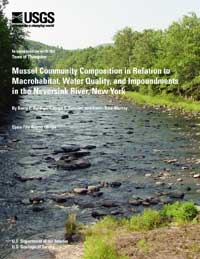 Mussel Community Composition in Relation to Macrohabitat, Water Quality, and Impoundments in the Neversink River, New York
Mussel Community Composition in Relation to Macrohabitat, Water Quality, and Impoundments in the Neversink River, New York
by Barry P. Baldigo, George E. Schuler, and Karen Riva-Murray
U.S. GEOLOGICAL SURVEY
Open-File Report 02-104
ABSTRACT
Decreases in mussel-species richness and
their distributions in rivers worldwide may
indicate that these long-lived organisms could be
adversely affected by recent changes in the
suitability of habitat and quality of surface waters.
Impoundments are considered major factors
contributing to these declines in rivers of North
American. Unionid mussels, other benthic macroinvertebrates,
and local physiographic, habitat,
and water-quality conditions were characterized
across a partially regulated river in southeastern
New York State during 1997 to evaluate factors
that affect the distribution of two rare mussel
species, Alasmidonta heterodon and
Alasmidonta varicosa, and the richness of mussel
communities. Results from multivariate analyses
indicate: (1) macrohabitat features such as percent
open canopy, mean channel width, mean bank
width, several water-quality factors (e.g.,
conductivity and pH), and site physiography (e.g.,
elevation and drainage area) were related to
mussel-community richness and the distribution
of A. heterodon populations; and (2) the
abandoned, low-head Cuddebackville Dam may
have restricted A. heterodon populations to the
lower reaches of the system. Impoundments may
have had both positive and adverse affects on
mussel populations in the Neversink River, thus,
the full effects of impoundments on biodiversity
of aquatic ecosystems need to be well understood
for effective management of water and biological
resources in rivers of the world.
Citation: Baldigo, B.P., Schuler, G.E., and Riva-Murray, K., 2002,
Mussel Community Composition in Relation to Macrohabitat, Water Quality, and Impoundments in the Neversink River, New York:
U.S. Geological Survey Open-File Report 02-104, 26 p.
 [Full Report, Acrobat PDF
(692K)]
[Full Report, Acrobat PDF
(692K)]
[an error occurred while processing this directive]
|
